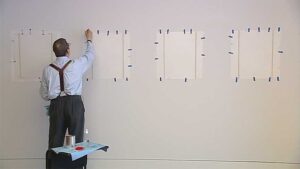By Makafui Aikins

Chapter 1: Utter Gibberish
“There is a sense of suddenness about Ryman’s early work, a feeling of arrival. Sometimes these paintings were completed with a cursive signature or just his initials, and a date, which had the appearance of yet another form rather than a self-regarding authorial flourish.
Ryman was taking painting apart to see how it worked, then reassembling it from degree zero. The support. The surface. The spread fof one material over another. The limits. Whether to paint to an edge or to contain and constrict. What the boundaries are and where they lay.
To paint to an edge or to overrun – like a cartoon character who keeps running till they realise they are already scrabbling in mid-air. He always came back from the brink. This is why his paintings are both so quiet and so exciting.”
Ladies and gentlemen, what is being described to us here is a white painting.
*****
I will be frank with you, I anticipated a far greater impact with that punchline right there. But judging by the breeziness with which you are still reading on, I’m afraid you may have completely missed it. Please pause for a second to contemplate this next sentence.
What I am trying to tell you is that that opening paragraph right up there, written by an art critic for ‘The Guardian’, was so done in description of some white paintings—the white paintings of Robert Ryman. And by white paintings I mean just that. The paintings were… just… white. And one of them famously sold for over US$20million.
Aww, aren’t you just the sweetest! Look at you still reading on. I thought you’d be suffering a cardiac arrest by now. Perhaps it is the lack of seeing that has caused this breeziness.
I have come to the conclusion that no punchline can be so great as to do the job of snapping you out of this nonchalance with which you are regarding the words ‘white painting’.
So, my brothers and sisters, kindly do me a favour of closing that newspaper of yours, and google Robert Ryman’s paintings—if you are not already acquainted with them. And while at it, also search this particular painting of his called ‘Bridge’—that piece which infamously sold for over US$20 million. I’ll wait…
*****
First of all, welcome back. Secondly…I know, right?! Ridiculous, isn’t it?! Maybe we should just end this piece right here. Because where do we go from here? What really is there to say? 20 million dollars! US$20,605,000, in fact. To have this large amount of money showered on this supposed art piece in the year 2015… Where do we take this conversation from here?
I can actually see you pausing on this. Contemplating it. When something is this ridiculous on its face, we begin to contemplate a deeper meaning—a deeper, hidden implication, perhaps, of which we are not privy.
Because most certainly there is no way anybody would just throw that much money on a piece of canvas just plastered with white paint… Surely there must be some concealed awe to it all. Maybe at night, the patterns of these paintings come to life, and mimic the constellations of the night sky.
Maybe its painter was, just like Van Gogh, allegedly traumatised to see very vividly, certain otherwise invisible natural phenomenon at play… Just as Vincent van Gogh was purported to have seen and painted the pattern of turbulence in his work, the Starry Night, I mean. Maybe these white paintings aren’t just white paintings after all.
Maybe…. maybe they are representations of something. SOMETHING. Something deeply concealed yet easily reachable when pointed to. Not something that ought to be forged out of nothingness by the consumer. Something REAL. Because 20 million dollars…?!
You know what, there is nothing more excruciating for a money-deficit human being than having to witness so much money get blown away. Hence, we are justified in seeking answers. You and I cannot afford to let this amount of money go to waste, so we ought to delve deeper…
There is a wryness, dryness, and whiteness to it
Indeed, there ought to be a deeper meaning to these paintings… Or maybe it’s the artist himself. Ryman. There perhaps is an essence, a purpose of which he has vividly expressed (overtly or covertly) that can, in turn, be vividly seen in his works—as seemingly dry as they may seem to us—upon close inspection. White paint on a medium—on canvas. Maybe there is a hidden splendour to it all. So, it is apropos that we search for Robert Ryman.
Oh, here he is, a young man born in Tennessee, USA in the year 1930. Ryman had wanted to become a jazz musician. Black music. That brilliant display of uncompromising otherworldly talent. Where music had been formulaic, jazz music comes in and lends ingenious improvisation to this world. Jazz music alters pre-existing notions of music and creates ethereal splendour still.
Knowing this dream in him would be left for dead in the South, his home, he moved to the North—New York city—at the age of 23 to pursue this dream. While at it, he took a job at the Museum of Modern Arts as a security guard to make ends meet. And it was during this stint that Ryman came into contact—according to him, for the first time—with actual artwork. Real art.
Beforehand, back home in Tennessee, the only art he had been exposed to were those generic printed images framed and found in various homes. Art was a whole profession? A respectable profession where one could make respectable income, and at-times attain worldwide acclaim? Count Robert in!
Of course, you have guessed the turn Robert’s life took.
But this turn, I must say, is open for interpretation. Because, here is the thing, it wasn’t only Ryman who took this turn from security guard at the museum to world famous artist.
You have other now acclaimed Minimalists such as Sol LeWitt and Dan Flavin, both then fellow colleagues of Robert also branching into this field of art—Minimalism—from their posts as security men. And regarding this, one commentator tries drawing this amusing picture.
Here you have these security guards, watching on, day by day, as ‘supposed’ artists paraded bland pieces as ‘supposed’ art—right under their noses.
They watched on as these ‘supposed’ artists made a living—sometimes grand living—out of the very mundane. So, what does Robert along with his colleagues do? Say to themselves, “Ah, if this is art then me too koraa I am an artist!”
And so begins their respective delusive journeys into the art world. No need for real artistic talents, no need for an art education. And they choose an ‘easy road’ into this art world. In the case of Robert, spewing artworks such as ‘Bridge’. All white paintings. No real subject matter, and as he liked to say ‘no picture making’, just the spreading of white paint onto a canvas.
Oh, but remember, “His work…soon graduated from painting on canvas to a variety of materials including wood, Plexiglass, aluminium, copper and gauze…” Ah, of course! Many art critics, having nothing in the form of real art—real subject matter of which to critique, to contemplate, when it comes to Robert’s works, diverge into descriptions of the very medium on which he presents these artworks—the canvas, the wood, the Plexiglass, etc, sometimes even his signature (as we see in the case of the opening paragraph of this article), and bizarrely, sometimes even the tape with which he attaches these artworks to a wall.
This is a very convincing picture, I must admit… Robert and his colleague scoffing or even ‘scamming’ their ways into the art world—into worldwide artistic acclaim even.
But I wasn’t satisfied. Because this is US$20.6million we are talking about! What depth, secret, splendour do these white paintings hold?! For my own sanity I needed answers. And what better place to find it than from the horse’s own mouth? So, I went to the horse—Robert.
Because art, coming in various forms, is a beautiful thing. For us humankind to forge meaning out of our very mundane existence; to add to the stock of worldly creations by, well, creating our own things, it is a very majestic act—almost spiritual when you think about it.
And I know, art is open to various and diverse interpretations—oftentimes, these interpretations are the consumer’s, not the artist’s. But when presented with such nothingness, such emptiness, such wryness, dryness as Ryman has presented the world with his endless series of white-on-white paintings, one has every right to seek more from the creator. Perhaps it is in directly deciphering the thinking behind his works that one can begin to better appreciate the significance of their emptiness and blandness.
So fittingly, the art world has done its fair share of inquiries. And I must say, having heard from the horse’s own mouth, I still hear nothing—nothing concrete. It really is just that, isn’t it? Emptiness. Take this 1-hour interview of Ryman by Barbaralee Diamonstein-Spielvogel in 1977, for instance. It was a hard 1 hour to have to sit through. But for you, I did—not that you asked for it.
During this interview, there was a lot of attempted intellectualisations of Robert’s work by Barbaralee. Oftentimes, she would make reference to a quote purportedly attributed to Robert himself in description of his works, hoping to glean from him, deeper expositions into them. You said such and such during such and such interview in description of your art; or did such and such thing during an art exhibition, what did you mean by that? She would ask. But these enquiries were met with bland responses and oftentimes, outright confusion by Robert, “I have no idea I ever said that.”
Chapter 2: None’s Mundane
“Art, coming in various forms, is a beautiful thing. For us humankind to forge meaning out of our very mundane existence; to add to the stock of worldly creations by, well, creating our own things, it is a very majestic act—almost spiritual when you think about it.” I meant every word of this paragraph right here.
Because surely this world cannot be just about the mundane—the act of surviving, of providing for ourselves and even for our families. There ought to be an essence, an awe to it all. We each have something in us, talents demanding a showing. An expression of our innermost selves.
And art, it is one of such powerful media through which we, humankind, show ourselves strong. So, I am seldom a cynic when the issue of art is brought—art coming in diverse forms. I honestly don’t know which part of me wrote Chapter 1 of this piece—that blatant disrespect for another human being’s artistic expression…
Because think about it—and this might be lost on us, a people who supposedly do not have a history, or more aptly, a people who have never truly bothered to uncover the fullest scope of their history… But when we are all dead and gone, and our entire millennium along with it, when the human beings of the year 3024 are the new modern people, any glimpse into our lives that may remain will be considered by them priceless discoveries.
Oh, for them to stumble upon pieces of our lives and consequently decipher how we may have lived in this 21st century of ours—an entire 1,000 years ago, what an absolute thrill it will be for them! That piece of sticky note on which, perhaps, you have written your to-do list for the day… Oh, should this paper survive the ruins of the years, and 1,000 years later be uncovered by these 31st century modern-day people, oh my brother and sister, you have no idea the rapturous excitement this discovery will cause!
- Meet Firdaus at 11am to discuss such and such
- Take such and such from Akosua at 2pm
- Call Dr. Avle at 4pm
- Lash Kekeli when he returns from school
This list of yours will be studied in labs; it will be subject to expert archaeological reviews; it will form for them, the basis for forming the economic, sociological, political picture of our era. The world will look upon it to form a picture of how life was like for us all. Of course, unless the internet survives the ruins—in which case we would have spoon-fed these 31st century people our entire lives. No mysteries there.
Please really think about it… As I said, this may be lost on us, for we as a people, have never taken pains to uncover and fawn over our history—our history predating slavery… But just think about the cave arts of the Ice Age, the Venus de Milo sculpture, the ancient city of Meroë in Sudan, the 2.5 inches long Venus of Hohle Fels (the estimated 40,000-year-old figurine dubbed the oldest figurine ever found), the so-called Ötzi the Iceman (a surprisingly well-preserved male corpse found amid sheets of melting ice between the Italian and Austrian border with some belongings of his all around him, believed to be over 5,000 years old), the Bakoni Ruins in Mpumalanga, South Africa, the Voynich Manuscript (the book that cannot be read; a 240-paged book written in an indecipherable language and accompanied by bizarre illustrations—real and imaginary; believed to have been written in the 1420s)… Each of these archaeological findings rocked and continue to rock the modern world. We are always excited when such glimpses into the lives of humans before us are given us.
Look at this man dubbed Ötzi, by all indications, your average man of his era, travelling from one place to the other, and meeting his untimely death…Look at this ordinary man being presently the most “intensely studied mummy in the history of archaeology.” The world, 5,000 years after his death, is utterly fascinated by him.
Funny thing is that whenever I think of the Voynich Manuscript, I am reminded of the coded language I created as a child—intended to communicate with myself to the exclusion of all others. I know…so stupid. But to think that some future generations might stumble upon that book containing this secret language and be delightfully confused and enthralled by it…
Indeed, our mundane life now, is a priceless discovery for future, future generations. That being said, please let’s all be careful of the evidence we leave behind—like the things you put in your to-do lists, for instance. For you don’t want to end up implicating the rest of us all in certain things. I’m just saying.
It goes without reiterating that it makes no sense dismissing or taking for granted any expression that proceeds from us—expressions lending credence to our existence; expressions that says to all who inhabit and will later inhabit this earth, “We were also here!”; expressions coming in diverse forms—in art, literature, scientific inventions, and the like.
But these white paintings… These all-white paintings that have secured for yet another White man, a place in world history… They incite in me, some sort of mixed feelings. Feelings of jealousy, stupefaction, anger…
Chapter 3: On Arrival
I don’t know if you’ve figured this out yet, but this article isn’t about Ryman. It is about us. It’s not Robert I’m interested in, but the people—the people that made him. This jealousy, stupefaction, and anger, they are incited not by Robert nor to his contemporaries, but the world from which they proceed. Because here is the thing: the West and much of the developed East, they have perfected the art of self-aggrandisement. We, in much of the developing world, and Africa particularly have, on the other hand, perfected the act of self-effacement. So, I must further clarify that the feelings of stupefaction and jealousy are directed at them—for their capacity for self-aggrandisement; and that of anger, at us—for our tendency towards self-effacement.
I am sorry, but since allusion has been freely made to ‘white’ the colour in this piece, let’s just go ahead and grant ourselves access to an uncensored allusion to ‘pseudo-White’, the people. So, there it is: White folks, they have, throughout their history, showed themselves true masters of the art of self-aggrandisement. And I don’t know if I can fully say I am mad about that—or have any right to be mad about that.
I have come to the realisation, as a person on the other side of the ‘colour spectrum’ and sadly, consequently, historical and present sociological, economical, and geopolitical spectrum (just as you are), that being mad about this solves nothing. For it is an admirable trait in fact. A trait deserving selective replication.
The White folk, they drop faecal matter from their anal region and insist upon its gold-status. They convince themselves and the world around them that that is priceless treasure. For the benefit of themselves and future generations, they will forge a sense of essence out of nothing. Nothing is ordinary; nothing is left to chance; nothing is left to nothingness—everything proceeding from their camp must be slapped with a god-status badge. Everything they do is, according to them, ‘goated’.
Indeed, the acceptance and craze over artists like Robert Ryman, speaks, not necessarily to the artists, but the society within which they find themselves. Heaven knows that I could splash all the white paint—or even black paint—I want on a canvas and still wouldn’t get a wealthy Ghanaian to part away with even 10,000 Cedis. Because to sell an all-white painting you need a white lie.
A white lie, it deceives itself, and painstakingly, oftentimes brutally, it undertakes to deceive the entire world around it… The white lie, it is relentless; it’s often bloody even. It takes all roads possible and forge totally new ones, just to get to what it wants. The white lie, it is dark—mighty dark.
“Oh! here we are to trade with you… Oh wait, fast forward, and there you are in chains heading to slave away and perhaps die in labour for us.”
“Oh, those days are behind us now, let us now trade civilly as equal nations. Fast-forward. Aha! There you are, still giving me all you’ve got for piecemeals. Why? Because you’re stupid and I am not.”
“Oh, what is it that you are wearing? Fitting for your climate? Hmph! Wear these instead! That’s the only way to exude civility.”
“What are those sounds you make when calling each other? Oh, those are your names? No! They don’t sound like ours! Take our names instead.”
“Oh, I have here, a piece of wood, a canvas that I have spilled some white pigments on, give me your million dollars in exchange for it.”
The white lie, it is necessary and efficient—but oftentimes too ruthless. So, let us try our hands on our own version, the black lie.
Fellow Ghanaians, on any day, Mona Lisa’s smile is your average person’s wry smile. But no, exceedingly brilliant is not enough to describe Leonardo Da Vinci. He’s uplifted to god-status. His genius forever etched in history—as far as the earth’s scheduled ruins would allow. Yes, the floors of Jackson Pollock’s art studios do bear a striking resemblance to his paintings themselves. But no, through the meticulous campaigns of Clement Greenberg, those canvases housing those splashes of paint have forever found their place in the fabric of the world—for generations upon generations. And Pollock’s name, it remains etched along therewith.
Their writers, their politicians, their artists, scientists, inventors, etc., all are strategically uplifted to such positions of prominence, and etched deeply into the fabric of the earth—in the contemporary world and in history.
For the White folk, they know that perception is everything. The perception had of the one, is ofttimes the perception had of the all. They know that it is by favourably regarding them as a whole that each of them may be so favourably regarded. So then, they will go on and on, waxing philosophical over the littlest things they do.
Nothing is too small, or too easy that the White folk won’t wax philosophical about—in this bid of self-aggrandisement. So of course, they will write, “There is a sense of suddenness about Ryman’s early work, a feeling of arrival…” in description of a bland all-white painting—many of which look just like your average plain canvas. Yes, sense of suddenness alright—as in suddenly you’re robbed of your US$20million.
And I, for one, say I am tired of being mad about this! I admire it, in fact.
Because look at us. Look at us, these homo sapiens placed upon this relentless world. A world looming so large and broad; spanning so large and broad. Relentless in its staying power. We come and go; it stays. As though a factory churning out goods; goods that go through a cycle and end up as garbage. Utter garbage.
From dust unto dust. Oh, the world, it makes fun of us all. A world that claims, each day, to present the evidence clearly before us—waterbodies, the trees, the animals, the air we breathe, all so intentionally placed… And even within our own bodies; each bone, each mass of flesh, nerves, all purposefully placed, alluding to an overarching meaning. Such a purposeful world, but at the end of it all, dust it is—none escaping it. A world that baits us with the facts, but being, at the end of it all, still withholding. A meaningless world.
We, meaningful people in a meaningless world are quite expectedly rendered beside ourselves. What use is this world to us, if we cannot find within it, space for the occasional folly—if we cannot squeeze out of it, some level of pretension here and there?
That I may slap my hand on a piece of canvas and immediately call it the most beautiful expression of art ever made—and perhaps find myself US$20million richer? US$20million better placed to take care of myself and my family?
And consequently, as there emerges more people like me, each lending their own artistic expressions to this formulaic world, what we would be doing is building collective wealth and more importantly, collective essence… Wealth of which goes on to benefit our entire society, our entire nation and continent; essence which would go on to benefit our entire race—placing us in such equal positions of prominence across the board.
You bring your Shakespeare, I bring my [insert a Ghanaian/African name]. You bring your Michelangelo, I bring my [insert another Ghanaian/African name].
Indeed, what will result is that this country of ours—having within it a great number of talented individuals, dabbling in the overt and covert splendorous, the outright pretentious, and the supposed pretentious—would end up accumulating for itself, both individual and national wealth. Employment. Enlightenment—and/or the perception of enlightenment. Global acclaim.
A deep sense of self. A place in world history. A people capable of forging culture out of nothing; forging wealth out of the vacuum; forging importance out of the otherwise mundane. This becomes our story too—just as has been for the White folk throughout history. To be able to whip out faecal matter from our buttocks and call it gold. Because when you think about it, it really is gold, isn’t it? One person’s bodily waste is another plant’s source of life, isn’t that the case?
Oh, what glorious times it would be for us. To finally exit our small national headspace where all one needs in life is to achieve some few millions—Cedis, I might add—and there they are, having been deemed to have “arrived”.
*****
Africans and Black people in general often have clear, outright geniuses. Yet ever so often, these geniuses are left to go to waste—unexplored, unuplifted, and definitely not strategically etched into history.
[And trust me, I know by yammering on and on about such supposedly existential matters, I risk being the ‘white painting’ here. But I have chosen to risk it.]
We have, since time immemorial, been blessed with the extraordinary, but very unfortunately, we have perfected the art of reducing ourselves to nothingness—even while the White folk consistently uplift their nothingness to positions of the extraordinary and god-statuses. In this world game of self-effacement versus self-aggrandisement—the latter consistently wins. A re-conscientisation is hence imperative. We are in need of it urgently. And I am convinced that you are convinced of this fact. Because—and I don’t know about you—but if I am left to choose between a society that lets deep meanings and profound talents perish unexplored, and one that dissects everything to the point of elevating even the most superficial to positions of the otherworldly, I sure will choose the latter—any day!
That being said, just take a look at me…
Oh, what is it that I have in my hands right now? A brush and a canvas? And what is it that you have in your hands? Oh, the Business & Financial Times? That means you have businesses and finances you oversee. Do I sense a contractual agreement brewing between us…? Whereupon I strike this brush of mine against this canvas. I’m innovative, so I will go with black paint instead—not white. Different shades of black—from Musou black, right up to ash. And I would call the painting something inventive like… Black. And you, well you would part with 20 million… Out of patriotism, I will drop the dollar sign in favour of the infallible Cedi. And this writer friend of ours, she would write an in-depth thesis into the inexplicable genius that is this black painting called Black—lending deep philosophical essence to your life…and, well, mine, and in fact, our country, continent, and race at large. All just because you dared to purchase this otherwise nonsensical piece of artwork. Oh, what glorious people we are!
Are we agreed on this dynamic?
Great!
Let me go grab my black paint.
>>>CEO & Co-founder of Nvame, a premier business development consultancy and publication firm. She can be reached via [email protected] and www.nvame.com










